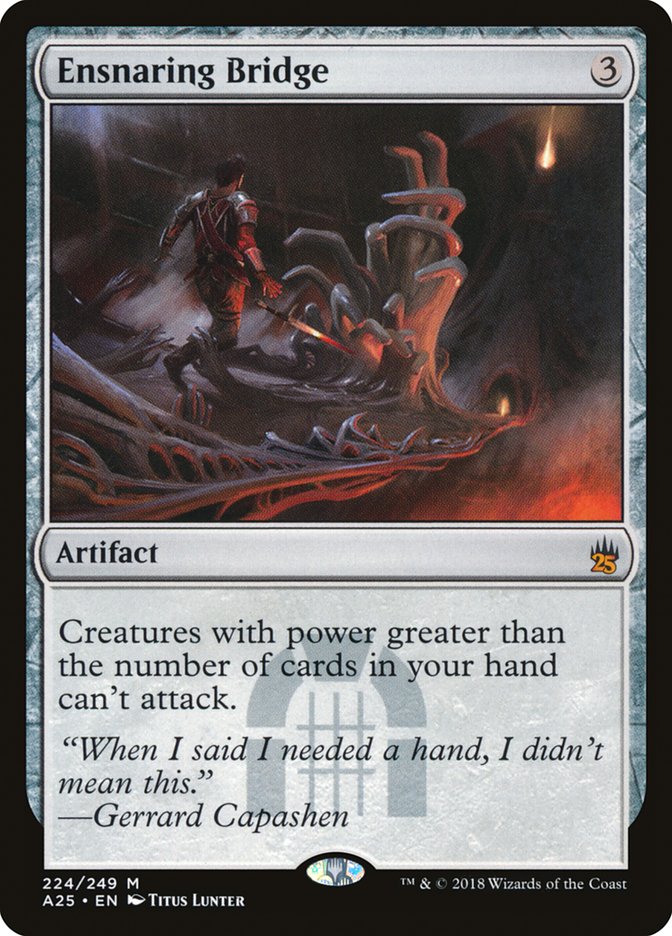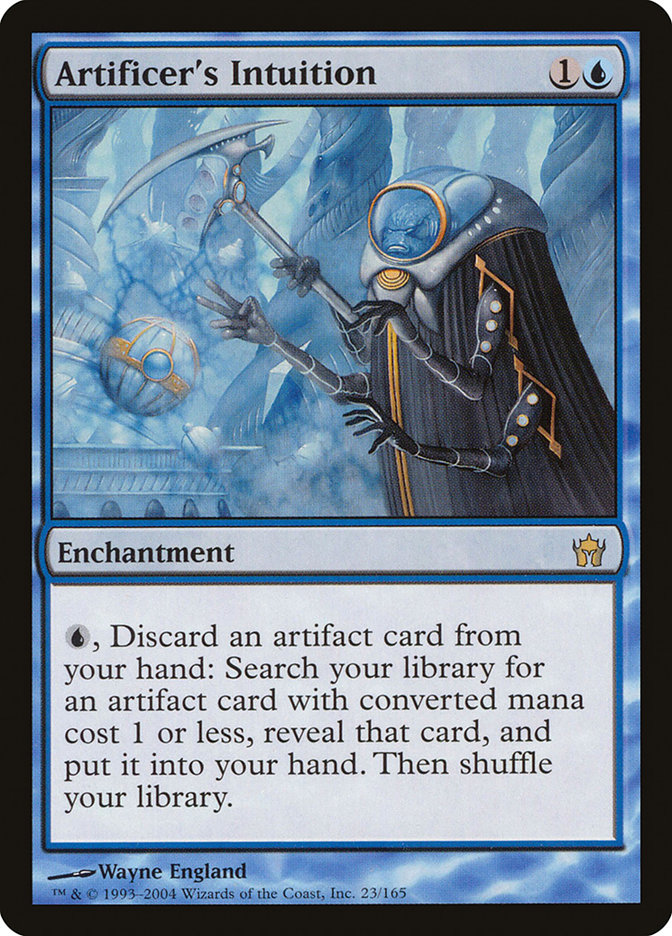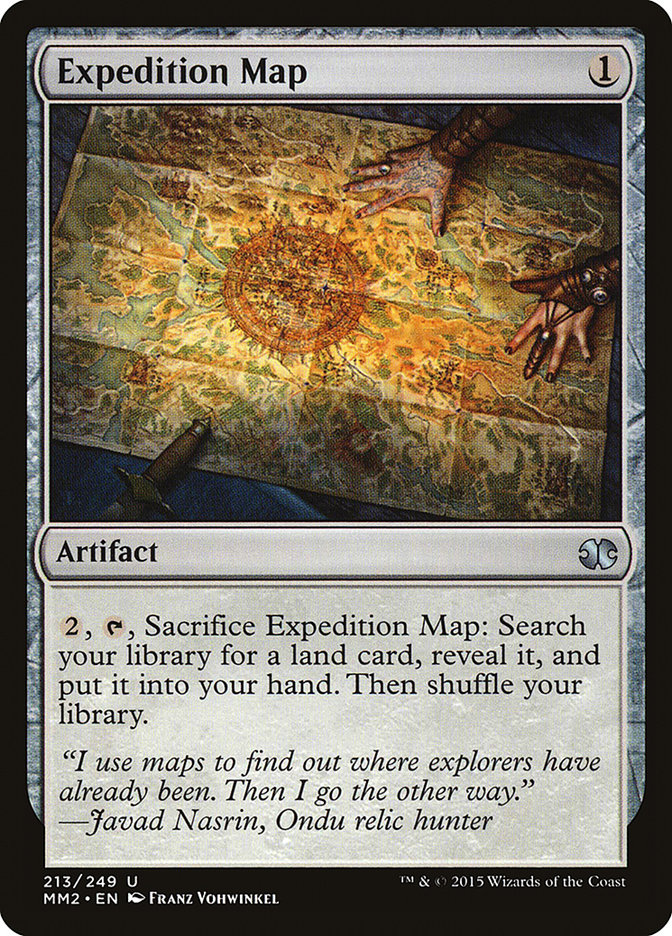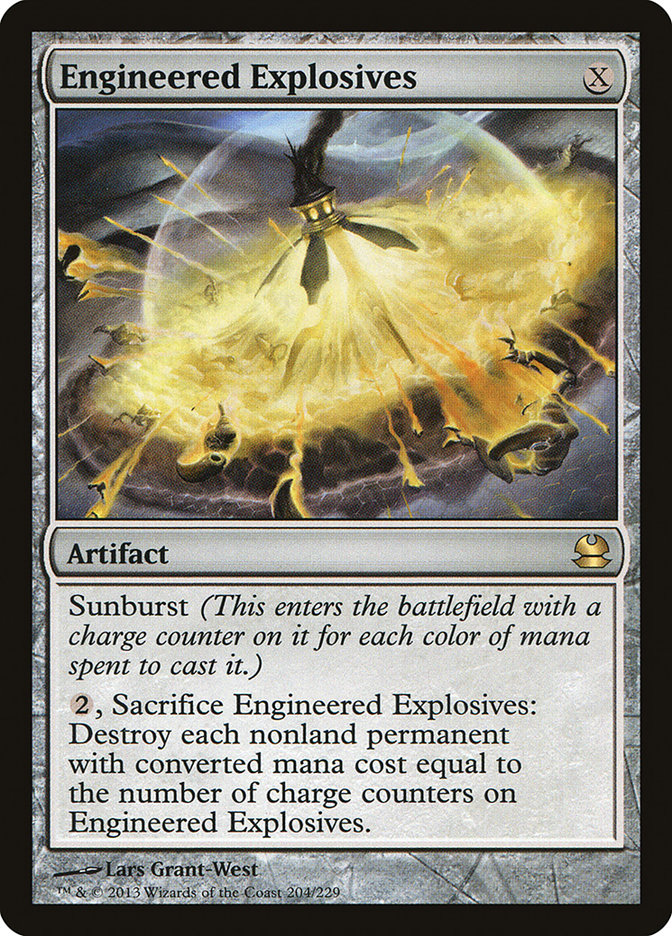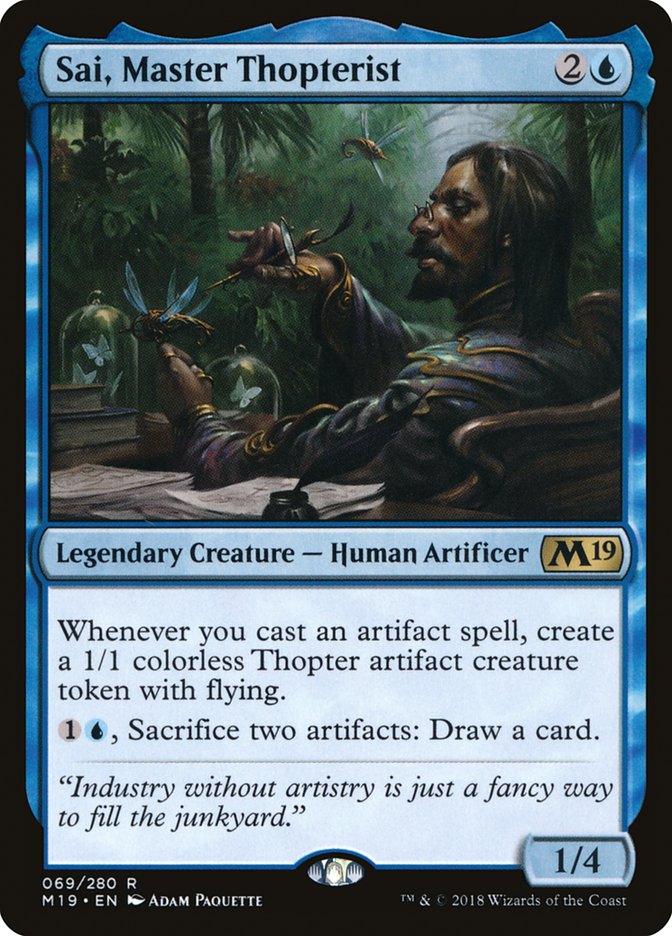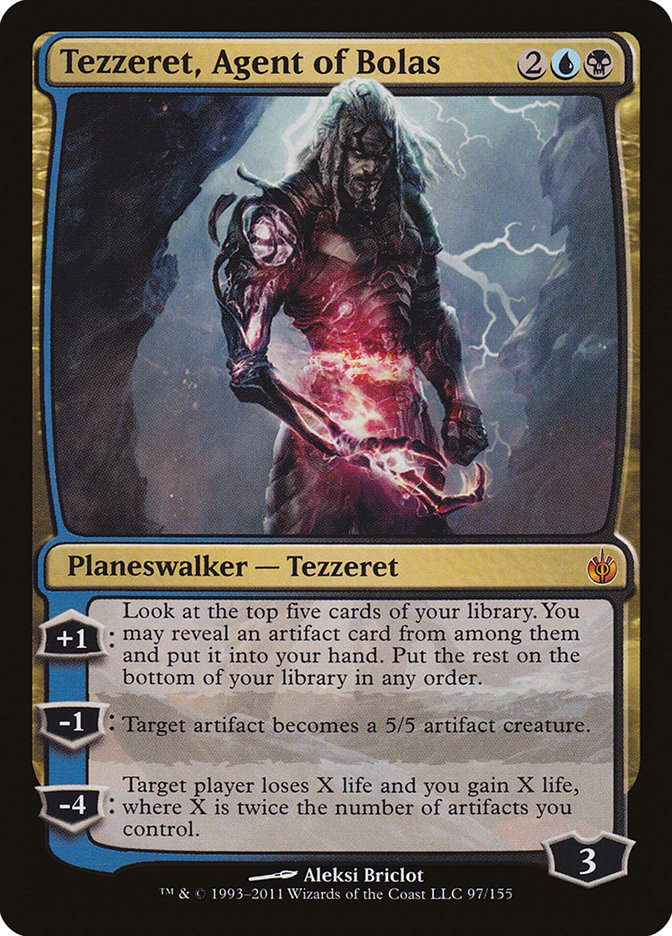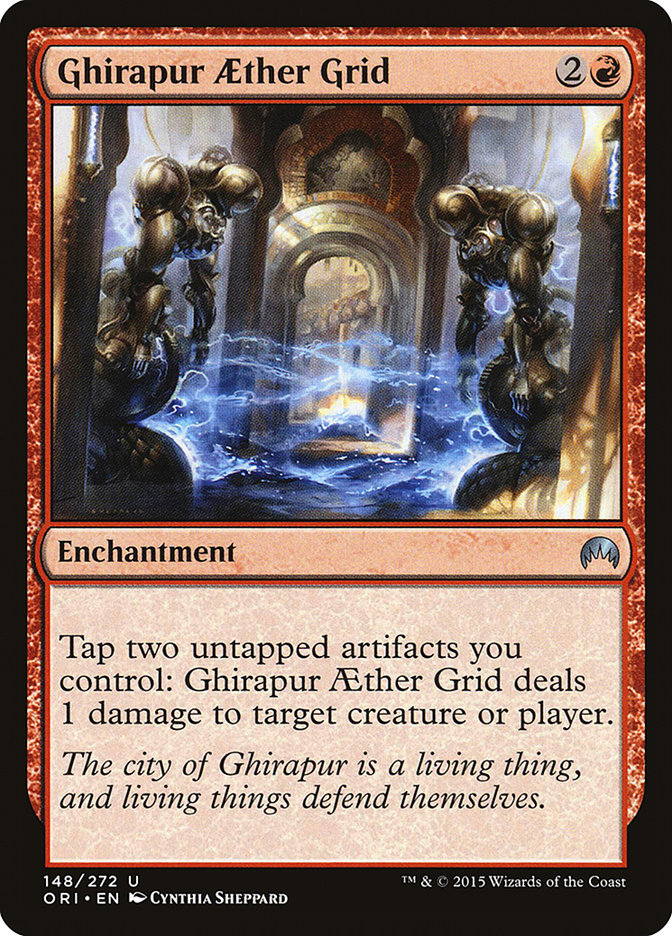The big story of last week’s Modern Open was the big resurgence of Dredge to the top tables, bringing one of my top five least favorite things to play against in Modern back from the grave to wreak havoc on the metagame.
I’m going to let Ross Merriam handle all talk of things Dredge this week, as he’s the expert, but I’m here to break the news on a deck that has the number one spot on my “I’d rather concede and get coffee” list of decks in Modern.
No, it’s not Lantern Control, or Skred Red, or even Tron. Feast your eyes on a deck that is far, far more miserable.
Lands (21)
Spells (39)
- 4 Ensnaring Bridge
- 1 Crucible of Worlds
- 1 Artificer's Intuition
- 1 Pyrite Spellbomb
- 1 Tormod's Crypt
- 3 Chalice of the Void
- 4 Welding Jar
- 3 Engineered Explosives
- 1 Pithing Needle
- 1 Bottled Cloister
- 4 Mishra's Bauble
- 2 Expedition Map
- 4 Mox Opal
- 1 Witchbane Orb
- 1 Grafdigger's Cage
- 4 Whir of Invention
- 2 Sorcerous Spyglass
- 1 Damping Sphere

This deck piloted by both Jody Keith and Jacob Koshak put two copies into the Top 8 of the Classic last Sunday, and I’ll be the first to say apologies to all the opponents who got locked out by these two on their way to their finishes.
Jokes aside, while I do think it takes a certain kind of brain to play prison decks like these, and they aren’t very popular. The results and construction of this deck are impressive and it should be taken very seriously as another one of the many decks in Modern you need to have a plan for. While Sun Tzu didn’t play many Modern tournaments (I checked the Deck Database and couldn’t find anything), when he said “Know the enemy,” he really nailed one of the biggest things to do when it comes to Modern.
I can’t count the amount of times I’ve seen befuddled players not understand what to do against prison decks like these and how to form a gameplan for beating them, but for all of you out there reading this, that ends today. Let’s start by breaking down the functionality of this Grixis Whir deck so we can understand what it can and cannot handle.
Nothing says “fun, interactive game of Magic” like these two Modern staples, am I right? These are the backbone of every prison deck in the format and serve as single-card lock pieces that can end the game on the spot. With so few answers to resolved artifacts played in Modern, one of these, especially Ensnaring Bridge, backed up by a single Welding Jar might as well be lights out.
This deck is built to execute its gameplan quickly, efficiently, and consistently. With thirteen zero-mana artifacts, not including Chalice of the Void or Engineered Explosives, to enable Mox Opal and Whir of Invention as fast ways to get down an Ensnaring Bridge, the game effectively can be ended before it even begins on the other side of the table. Once this deck sets its rules of engagement with Chalices or an Ensnaring Bridge, it has quite a few tools to keep the opponent from freeing themselves up until ultimately they assemble Crucible of Worlds and Ipnu Rivulet to run your library out of cards.
I’d like to give a quick shout-out to the singleton Artificer’s Intuition in this decklist, as I hadn’t seen that card since a legendary Deck Tech with Greg Hatch years ago, and while this deck isn’t as wacky or as fun as that combo deck from another age, it warmed my heart to see it make an appearance. In a realistic sense, it does act as a kind of fifth copy of Whir of Invention that is made to find your small things rather than the big ones. With multiple copies of X-cost artifacts such as Engineered Explosives or Chalice of the Void and things like Expedition Map, you can set up some complicated roundabout ways of tutoring up what you need, starting from pretty much nothing.
While a lot of the dangerous parts of this deck rely upon artifacts and the graveyard, the sideboard here is more than prepared to beat copies of Stony Silence and Rest in Peace. Ghirapur Aether Grid; Sai, Master Thopterist; and Tezzeret, Agent of Bolas are all excellent ways to punish hate cards without backup. Having so many creature based threats in Games 2 and 3 also forces more potentially dead cards to stay in the opponent’s deck, as an unchecked Sai can quickly win a game in a deck with such a high density of artifacts. My heart would sink to my stomach if my opponent started the game with a Chalice of the Void on one followed by a Sai, Master Thopterist, or if my Inquisition of Kozilek was staring down a Tezzeret, Agent of Bolas. Resilience is the name of the game, and a surprise attack like this can be exceedingly punishing for even the players who think they came prepared.
A way I like to think about decks like these is to separate them into the packages that make them whole. Some of the packages in this deck are:
- Bottled Cloister and Ensnaring Bridge to always have zero cards in hand on the opponent’s turn.
- Ghost Quarter, Tectonic Edge, and Crucible of Worlds to remove an opponent’s manabase.
- Inventors’ Fair and Crucible of Worlds to continually find the right artifact, provided enough mana.
- Academy Ruins and Pyrite Spellbomb as an alternate win condition when Chalice of the Void is not on one.
- Academy Ruins and Welding Jar to ensure multiple instances of protection against artifact destruction.
- Whir of Invention alongside silver bullets such as Damping Sphere, Grafdigger’s Cage, and Witchbane Orb.
These are all big pieces of the deck’s master plan, and anticipating which ones your opponent will pursue can tell you a lot about what your plan should be. Moreover, it should tell you what your gameplan shouldn’t be, too, because you don’t want to commit all your resources to a gameplan your opponent came prepared for.
The good news about a deck like this is that, unlike Lantern Control, this deck does not get to control what cards you’re drawing every turn, so there’s more opportunity for play that breaks things up.
Lands (18)
Spells (42)
- 3 Ensnaring Bridge
- 4 Lantern of Insight
- 1 Pyrite Spellbomb
- 2 Pithing Needle
- 3 Mishra's Bauble
- 3 Thoughtseize
- 4 Ancient Stirrings
- 3 Inquisition of Kozilek
- 4 Mox Opal
- 2 Surgical Extraction
- 1 Witchbane Orb
- 1 Ghoulcaller's Bell
- 1 Grafdigger's Cage
- 1 Abrupt Decay
- 4 Codex Shredder
- 1 Pyxis of Pandemonium
- 4 Whir of Invention

By now we’re familiar with what Lantern Control does. It is designed to set up a position the opponent cannot win through with what’s in their hand, and then it uses Lantern of Insight alongside mill effects to control your draw steps until you no longer have answers to draw to. This Grixis Whir deck, on the other hand, is designed to invalidate your cards in broad sweeps with effects like Chalice of the Void, Pithing Needle, and Sorcerous Spyglass. Overall, I find a deck like Lantern Control easier to steal games from, yet harder to beat when I think about them in a vacuum.
A big weakness of planning to lock the opponent out with sets of broad and narrow answers is that they are imperfect. For instance, if I am playing Azorius Control, I’m not very scared of most of what my opponent is doing because I have cards like Cryptic Command and Teferi, Hero of Dominaria that can remove permanents from the battlefield indiscriminately. This means my gameplan can be to use Jace, the Mind Sculptor to set up an ultimate activation and then choose to fight over Crucible of Worlds and Academy Ruins as ways to prevent that from winning the game. With the mana denial aspect of their gameplan solved, I’m no longer forced into the patterns they are creating of only being able to cast cheap spells which get countered by a Chalice of the Void on the battlefield.
If my opponent has a Tectonic Edge, I can do things such as choosing not to play a fourth land or another nonbasic land to protect my mana sources for future spells I need to cast. Tiny things like this are crucial to consider when you are playing against a prison deck because often you are picking one axis to break free on, and nothing else matters.
Take some time when you’re paired in a matchup like this, or ideally before a tournament, to ponder your plan to beat prison on the other side of the table. It’s a fun way to understand your Modern deck better, and Future You will certainly thank you for it. Your prison opponent came to the table with that knowledge ready to stop you, so it’s only natural that you clue yourself in too if you want to succeed. Maybe you’ll even think of something they don’t.
The other side of the coin of the success of this deck is what it means for Modern right now. As can be indicated by the dominance of linear but flexible aggressive decks like Dredge and Humans, a deck like Grixis Whir deck stands to become even better-positioned as time goes on. Ultimately, as fair decks prey upon the linear aggressive strategies, linear unfair strategies get stronger and stronger within the metagame. These can be decks like Burn or Ad Nauseam, but I fear decks like Lantern Control or Grixis Whir consist of so many unfair cards and produce unbeatable battlefields with such consistency that they lack a natural predator which can come in and shut them down.
Perhaps if these strategies gain more traction, more copies of Engineered Explosives, Hurkyl’s Recall, and Shatterstorm will start to make their way back into people’s sideboards, but until then I’ll have to hope this bandwagon isn’t one that gets hopped on any time soon.
Good luck to everyone playing alongside me in SCG Charlotte! Don’t get locked out!



